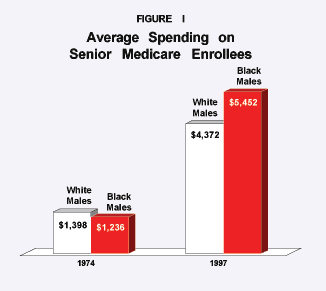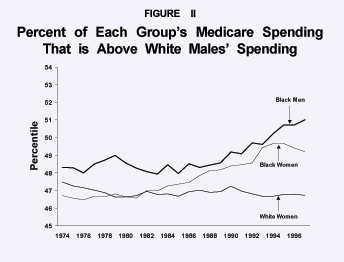Utilization of medical care has risen dramatically since Medicare began in 1965. That year, health expenditures accounted for 5.7 percent of the nation's output. By 2000, the size of the health care sector had risen to 13.2 percent. This dramatic rise has been hastened by Medicare's growth. In 1970, Medicare accounted for 11 percent of all health care expenditures in the United States; but by 2000, its share stood at 17 percent. As health care spending has grown faster than the economy as a whole, so Medicare expenditures have grown even faster than health care expenditures in general.
In the future, Medicare will consume an even greater share of the nation's output because (1) the numbers of beneficiaries will increase as the baby boomers retire; (2) increases in life expectancy will lengthen retirement periods; and (3) medical costs will rise as medical expenditures grow faster than the economy as a whole. Medicare's claims on our national resources are expected to double between now and 2035.
What explains Medicare's rapid growth? Part of the answer involves the changing pattern of health care use by different groups of beneficiaries. Women and minorities are widely believed to have been shortchanged in the U.S. health care system. If spending differentials in the past were worse than today, some of the growth in Medicare spending may be due to spending by women and minorities catching up with that of white men.
Patterns in Reimbursements by Race.
As Figure I shows, there were significant differences in the use of Medicare in the mid-1970s. For example:
- In 1974, the average white male senior citizen received about 13 percent more Medicare services (as measured by spending) than the average black male senior citizen.
- Among women, the average white beneficiary received 18 percent more services than the average black beneficiary.
By 1997, however, these discrepancies not only had disappeared, they had reversed. For example:
- In 1997, the average black male was receiving almost 25 percent more in Medicare benefits than the average white male.
- The average black female was receiving about 37 percent more in Medicare benefits than the average white female.
Patterns in Reimbursements by Gender.
A similar pattern can be formed by comparing the average Medicare spending of men and women over time. For example:
- In 1974, white men, on the average, were spending 12 percent more Medicare dollars each year than white women, and black men were spending 17 percent more than black women.
- By 1997, the spending gap between men and women had narrowed from 12 percent to 5 percent among whites.
- Among blacks, the discrepancy actually reversed, with black women spending 5 percent more than black men that year.
Evidence of Inequality.
These numbers might suggest to some that there was significant inequality based on race and sex a quarter-century ago. Specifically, the raw averages reported above are consistent with the notion that there was inequality in Medicare spending in the 1970s, but at least when comparing average spending by blacks and whites the inequality has disappeared over time. But are these averages conveying an accurate picture? Or are they misleading?
Comparing Groups by Sex and Race.
One of the difficulties in comparing groups of people is that other things are not always the same. For example, the average retired woman is older than the average retired man and, in general, the older a person is, the higher the medical expenses. Also, averages can be distorted when large numbers of beneficiaries make no use of the system in any given year, since in computing an average each of the nonusers generates a zero entry. Averages are also skewed by expenditures at the upper end of the distribution.
One of the most striking changes over the past 35 years has been the decrease in the percent of Medicare beneficiaries who make no use of the system in any given year. For example, in 1974, more than half of the program participants (53 percent) did not receive any benefits from Medicare. This ratio has declined over time, but there were still approximately a quarter of beneficiaries (25 percent) who had no reimbursements in the last sample year, 1997. 
Closer examination reveals that there has been very little change in the percent of beneficiaries who claim Medicare Part A benefits, which are mainly hospital services. The fraction of seniors using Part A is roughly equal to one-fifth of all beneficiaries in any given year. However, there has been a major change in claims on Medicare Part B benefits, which are mainly physicians' services.
For example, the share of male beneficiaries who had (and had only) Part B payments jumped from only 23 percent in 1974 to 52 percent in 1997. Females who claimed only Part B benefits almost doubled, rising from 29 percent to 57 percent between 1974 and 1997.
Adjusted Findings.
We have used statistical techniques that adjust for these problems and produce more accurate measures of average spending. (The methodology is explained in the reference provided below.)
- After all relevant adjustments are made, white women consistently had lower spending than white men over the 25-year period. [See Figure II.]
- Spending by black males has been growing relative to that of white males, and since 1994 their spending has been above that of white males.
- Since 1983, black females have consistently received more benefits than white females, and their spending has been growing when compared to that of white males.
Conclusion.
Retired women spend less on health care than do men, after adjusting for the effects of age. Further, the spending pattern has been stable over time and has not contributed to the growth in Medicare spending. However, part of the growth in per capita Medicare spending appears to be attributable to the growth in reimbursements made on behalf of blacks relative to whites, as inequality in Medicare reimbursements between racial groups has narrowed over time. Given that the gap has been largely eliminated, we do not expect future Medicare growth to be affected by further increases in relative reimbursements made on behalf of blacks.
Andrew J. Rettenmaier and Zijun Wang are with the Private Enterprise Research Center at Texas A&M University. Rettenmaier is a senior fellow with the NCPA. This analysis is based on "Dimensions in Medicare Spending," available at http://www.tamu.edu/perc/